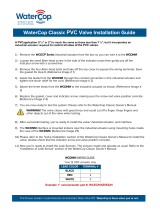5.2.2 LOW GAS PRESSURE TEST: BMK3000 – 6000 Only..................................................................................... 61
5.3 HIGH GAS PRESSURE TEST ......................................................................................................... 65
5.3.1 HIGH GAS PRESSURE TEST: BMK750 – 2500 .............................................................................................. 65
5.3.2 HIGH GAS PRESSURE TEST: BMK3000 – 6000 Only .................................................................................... 67
5.4 LOW WATER LEVEL FAULT TEST ................................................................................................. 71
5.5 WATER TEMPERATURE FAULT TEST .......................................................................................... 72
5.6 INTERLOCK TESTS ........................................................................................................................ 73
5.6.1 Remote Interlock Test .............................................................................................................................. 73
5.6.2 Delayed Interlock Test .............................................................................................................................. 73
5.7 FLAME FAULT TEST ...................................................................................................................... 74
5.8 AIR FLOW FAULT TESTS-BLOWER PROOF & BLOCKED INLET SWITCHES .............................. 75
5.8.1 Blower Proof Switch Test ......................................................................................................................... 75
5.8.2 Blocked Inlet Switch Test .......................................................................................................................... 77
5.9 SSOV PROOF OF CLOSURE SWITCH CHECK ............................................................................. 78
5.10 PURGE SWITCH OPEN DURING PURGE .................................................................................... 79
5.11 IGNITION SWITCH OPEN DURING IGNITION .............................................................................. 81
5.12 SAFETY PRESSURE RELIEF VALVE TEST ................................................................................. 81
SECTION 6: STANDALONE MODES OF OPERATION ....................................... 82
6.1 OUTDOOR RESET MODE .............................................................................................................. 82
6.1.1 Outdoor Air Temperature Sensor Installation ........................................................................................... 82
6.1.2 Outdoor Reset Mode Startup ................................................................................................................... 83
6.2 CONSTANT SETPOINT MODE ....................................................................................................... 84
6.3 REMOTE SETPOINT MODE ........................................................................................................... 84
6.4 DIRECT DRIVE MODES.................................................................................................................. 85
6.5 AERCO CONTROL SYSTEM (ACS) ................................................................................................ 86
6.6 COMBINATION CONTROL SYSTEM (CCS) ................................................................................... 87
6.6.1 Combination Control System Field Wiring................................................................................................. 88
6.6.2 Combination Control System Setup and Startup ....................................................................................... 88
SECTION 7: BOILER SEQUENCING TECHNOLOGY........................................... 90
7.1 INTRODUCTION ............................................................................................................................. 90
7.1.1 Installation Notes ..................................................................................................................................... 91
7.2 BST IMPLEMENTATION INSTRUCTION ........................................................................................ 91
7.2.1 BST Setup: Constant Setpoint ................................................................................................................... 93
7.2.2 BST Setup: Remote Setpoint ..................................................................................................................... 94
7.2.3 BST Setup: Outdoor Air Temperature Reset .............................................................................................. 95
SECTION 8: MAINTENANCE ......................................................................... 98
8.1 MAINTENANCE SCHEDULE ........................................................................................................... 98
8.2 BENCHMARK 750-5000N IGNITER-INJECTOR .............................................................................. 99
8.2.1 Pilot Ignition – Benchmark 5000-6000 .................................................................................................... 101
8.3 FLAME DETECTOR ...................................................................................................................... 101
8.4 O2 SENSOR (IF EQUIPPED) ......................................................................................................... 102
8.4.1 Air Eductor Air Pump Maintenance – BMK5000 & 6000 ........................................................................ 103
8.5 SAFETY DEVICE TESTING .......................................................................................................... 104
8.6 BURNER INSPECTION ................................................................................................................. 104
8.7 CONDENSATE DRAIN TRAP ........................................................................................................ 107
8.8 AIR FILTER CLEANING AND REPLACEMENT ............................................................................. 108
8.9 REFRACTORY REPLACEMENT – BMK5000 & 6000 ONLY ........................................................................ 109

























